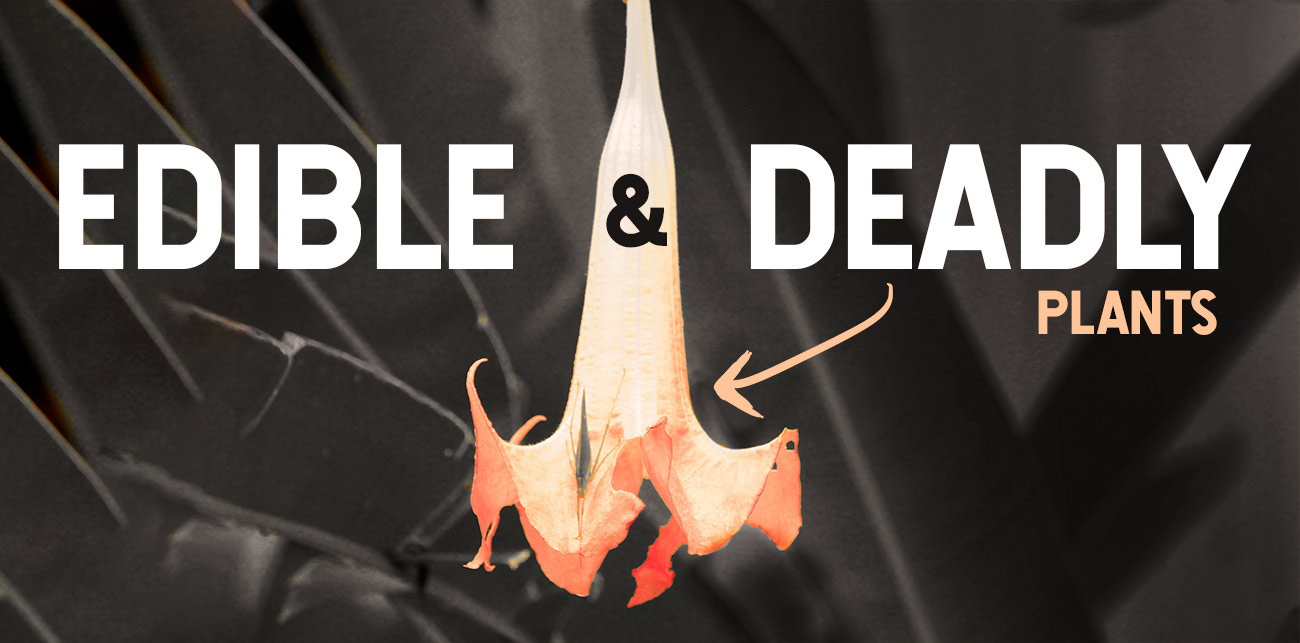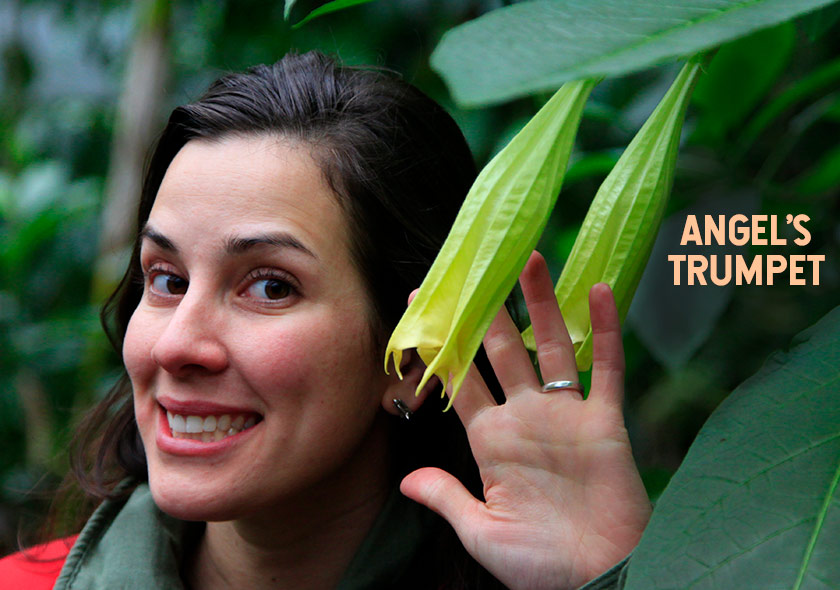Know these Edible and Deadly Plants


If you watch Harry Potter and long to take herbology or potions class so you can learn the mystery and magic of plants in the world, you’re in luck! Plants are amazing, and learning to identify and use them in traditional ways (even some in your own backyard) is about as close to real magic as it gets in the muggle world! At their most fundamental, plants can provide shelter, food, oxygen and warmth. Plants can contain deadly poisons and cures for a myriad of maladies. The forest is a natural medicine cabinet, and using this diverse resource the right way can certainly make you feel like you’re at Hogwarts concocting healing potions! There are so many things you can do with plants, if only you know what you’re looking at. That’s why plants are essential to basic wilderness survival. Even though this is a broad crash course in some great plants to know, I hope you get a sense of how important they are to all of us. And with a little research, I bet you’ll find the natural history and uses of real plants to be just as fascinating as fictional ones. Even though mandrake root is not actually a live humanoid baby with a scream that can render you unconscious, REAL mandrake has hallucinogenic properties reportedly used in rituals dating back to Norse paganism!

Let’s start with poisonous plants. Here are some basic guidelines to keep yourself from dying from a poisonous plant.
How Not to Become a Plant-Induced Corpse
- Learn as much as you can. That’s why you’re reading this book. This is the first step. Learn which plants you can eat and which are deadly.
- Never eat plants you don’t know. Surely someone in history came upon an unknown plant and tasted it. If they died, we learned not to eat it. Today, all that hard work is done. You can learn to correctly identify plants with guides and many other resources (like taking one of our wilderness survival courses) before you just go popping it in your mouth.
- Cover your skin. Many plants cause some irritation if touched. Poison ivy or stinging nettles won’t be as much of a problem if you’re wearing pants and long-sleeves.
- Wash your hands. Believe it or not, but if you wash your hands after touching a toxic plant, you’ll probably be fine! The skin on your fingers is tough. Touching your eyes, nose or eating the plant afterwards is the real danger.
- Touch pets with care. A dog or a rabbit can run through poison ivy and not have a problem. You can actually get it from them just by petting their oily fur.
- Make fire with known plants. Since some plants are toxic because of the chemicals inside them, burning them will consequently release some really terrible compounds into the air. You don’t want to breathe in that smoke!
Edible / Useful Plants
I am a huge fan of eating wild edibles. In fact, I want to start with some of those after we’ve established some ground rules:
- Don’t eat something you haven’t certainly identified. Many plants look similar, so you want to make sure you use every possible resource to correctly identify a plant. Going out to learn plants with a guide or taking a wilderness course is the safest way to begin.
- Avoid eating any plants growing in places with pesticides or possible contamination – railroads, golf courses, public areas with lots of traffic, and along roadways.
- Try edibles at first in small amounts. This makes sure you don’t react poorly to something. Even if something is not poisonous, it still may not agree with you – so starting small is the smart way to go.
- Don’t mix a lot of plants together until you’re familiar with them.
I start first with a few of the many edible plants that you can eat. Knowing these is actually important for survival situations as you can forage and survive with just this little bit of wilderness knowledge. It’s also a fun way to look at the world and discover there are many things to eat right nearby! Here is a short video to get you started, and a list of a bunch more!
Dandelions: Most people wouldn’t think you can eat dandelions, but they are definitely edible. They are one of the easiest to identify as well. The flowers are really tasty and good for obtaining vitamin D.
Currants: Currants have a lot of wonderful vitamin C. They’re tasty and somewhat tart at times.
Wild Onions just like our domesticated onions can be harvested and added as amendments to your dishes.
Alfalfa: Alfalfa seeds and dried leaves can be taken as a supplement for their nutritional qualities. The seeds can be sprouted and eaten in the form of alfalfa sprouts.
Violets: Violet flowers contain high amounts of vitamin C. The leaves are also high in vitamin A. They make a colorful and tasty addition to salads.
Grass: All grasses are edible, but some are tastier than others. The woody bits are somewhat difficult to digest, so it’s best to find the most tender parts of the grass or simply more tender types of grass – like ryegrass.
Salsify: This is closely related to dandelions, but they’re not bitter like dandelions. You can harvest the flower buds and growing meristems. There is white sap in the plant that is also perfectly ok to eat.
Wild mustards: Mustards are extremely nutritious and add a lot of spice to meals. All mustard plants smell like mustard so this is one easy way to identify them beyond their morphology.
Shepherd’s purse: The entire plant is edible, but the seed pods are the distinguishing features. They look like small hearts.
Pineapple weed: Also known as wild chamomile, it is completely edible. The best way to identify pineapple weed is via their smell. It smells a lot like pineapple.
Lamb’s Quarters: It looks much like quinoa and tastes like spinach. It grows as a weed all over the world and contains a lot of calcium. The smallest leaves are the most nutritious.
Green Amaranth: This plant has a big spiky seed pod on the top. You wouldn’t eat the seed pods, though. You would, instead, eat the smooth stems and leaves.
Common Mallow: This is a related plant to okra. The disk-shaped leaves are tasty. The disk-shaped button fruits are really delicious. You can boil it and use it in gumbos, just like okra.
Purslane: The entire plant is edible. This is the number one wild edible for omega 3 fatty acids. It can be found almost anywhere sprawling low along the ground.
Roses: All roses are edible and people love to grow roses. They are rich in iron. Leaves can be used in salads (so long as you haven’t put pesticides on them). The petals, buds and rose hips are also edible.
Miner’s lettuce: It’s the romaine lettuce of the wild edible world. The big heart shaped leaves are great for salads.
Deadly Plants
Knowing the dangerous and deadly plants is important. If you at least know the deadly ones first, then you can have some confidence that you can experiment a bit with others I listed above. Just remember that if you’re unsure or new to all this – don’t do it alone. I highly recommend you find someone with more knowledge of plants to teach you. There are some great wilderness courses out there that have an edible plant component if you want some hands on experience with experts. I have taken groups like this out all over the world like I do now via StoneAgeMan.com.
Poison hemlock: The Greek philosopher, Socrates, is said to have died by drinking a concoction made with poison hemlock.
Death Camas: Resembling wild onion in its early leaves, death camas contains the alkaloid, zygacine – which if consumed is potentially lethal to humans.
Monkshood: This is one of the most deadly plants in existence. It’s also called wolfsbane and was often used in the homesteading days to poison wolves by adding this to the meat of dead animals.
Oleander: Death is somewhat rare from this plant, yet many legends exist about it. One legend has it that cooking a hot dog on an oleander stick will kill you. That’s not true. But, sadly, there are accounts of small children who have died from eating leaves off oleander hedges.
Poison Ivy, Poison Oak, Poison Sumac: Even though we spent an entire chapter on poison ivy, it’s worth a reminder here that there are plants that contain oily resins that can cause terrible allergic reactions. The more exposure you have to these plants, the quicker your body gets an immune response meaning you react more with more exposure.
Angel’s trumpet: Many homes in the tropical south have this beautiful flower growing outside in their yard, yet eating a flower is enough to send you into terrible hallucinations and even kill you.
Foxglove: Also known as dead man’s bells or witch’s gloves, this beautiful ornamental plant contains a host of toxic glycosides. One is digoxin, a powerful drug that can stop your heart. Taken in small doses, though, it is used to treat patients with congestive heart failure.
Jimsonweed: While a hallucinogenic plant that has been used in traditional medicine for millennia, the likelihood of an overdose is high. It contains dangerous levels of atropine, hyoscyamine and scopolamine.
White Snakeroot: People can die simply by drinking the milk of animals that would eat this plant. In fact, it killed Abraham Lincoln’s mother – who coincidentally is one of my ancestors!
Deadly Nightshade: It looks a bit like blueberries or small tomatoes. It contains atropine and solanine.
Hellebore: While a common yard plant for gardeners, it’s also somewhat toxic. A new theory suggests this may have been the plant that killed Alexander the Great.
Other Deadly Plants
There really are a lot of plants that are deadly or toxic to some degree. I mean, plants are just sitting there and without some sort of toxin to deter would be grazers, how would they survive?
These are a few others to be aware of and look up for their deadly toxic characteristics. Plus, I think some of their names are just terrific!
Belladona, castor bean, dumb cane, manchineel tree, white snakeroot, rosary pea, pokeweed, mountain laurel, white baneberry, corn cockle, larkspure, wild poinsettia, jack-in-the-pulpit, iris, daffodil, elderberry (uncooked), stinging nettle, giant hogweed, and wild parsnip
Prefer Listening?
If you’d rather listen to this article, I’ve recorded it here to make it as accessible as possible.

